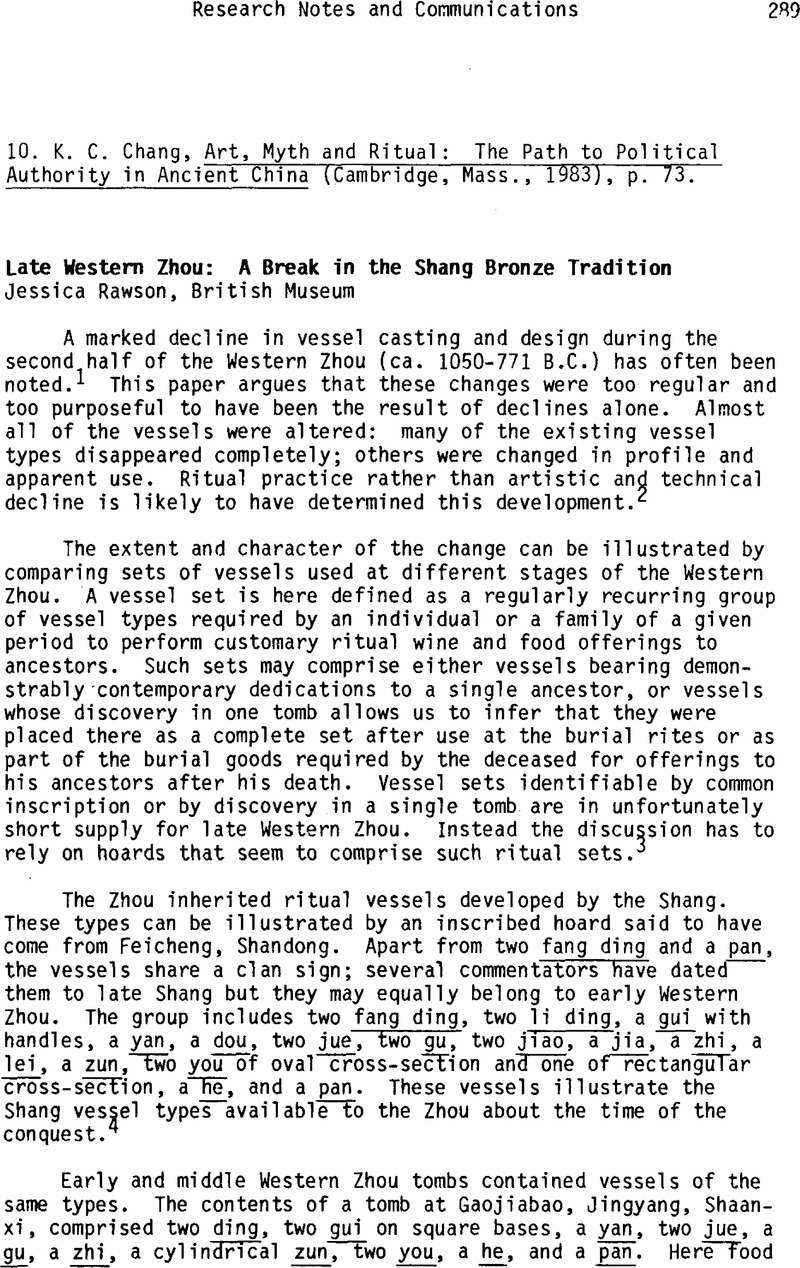Published online by Cambridge University Press: 26 March 2015

1. Most authors have treated the observed changes as evidence of artistic and social decline. The clearest recognition of the importance of the issue is found in Karlgren, Bernhard, “Yin and Zhou in Chinese Bronzes,” Bulletin of the Museum of Far Eastern Antiquities 8 (1936): 141–148Google Scholar; Karlgren, Bernhard, “New Studies on Chinese Bronzes,” Bulletin of the Museum of Far Eastern Antiquities 9 (1937):2Google Scholar.
2. This article summarizes a paper presented to the Early China Seminar at the School of Oriental and African studies on 11 March 1986. A fuller and somewhat different presentation of these arguments will be found in the author's work, Western Zhou Rituai Bronzes in the Arthur M. Sackler Collections (Harvard University Press, forthcoming), Introduction, Section 4.2.
3. Defining a ritual set is hazardous. Vessels in a given tomb may be of various dates, but they probably indicate the range of vessels in use at the time of interment. Useful descriptions of vessels found together are given in Baojun, Guo, Shang Zhou tongqiqun zonghe yanjiu (Beijing: Wenwu chubanshe, 1981)Google Scholar; Minao, Hayashi, In Shū jidai seidōki no kenkū (In Shū seidōki soran ichi) (Tokyo: Yoshlkawa kobunkan, 1984):160–163, table 7Google Scholar.
4. The vessels are described in Wenwu 1982.9:34–43Google Scholar; see also Shimin, Wang and Yachu, Zhang, “Yindai Yi Xin shiqi qingtong rongqi de xingzhi,” Kaogu yu wenwu 1986.4:46–67Google Scholar.
5. The use of water vessels by the Zhou is discussed by Lingsheng, Zhang, “Shuo he yu yi qingtong yiqi zhong de shuiqi,” Gugong jikan 17, no. 1 (1982): no. 25-40Google Scholar.
6. The excavation of the tomb is reported in Wenwu 1972.7:5–8Google Scholar.
7. The excavation of the tomb is reported in Wenwu 1979.11:1–11Google Scholar.
8. The “Chang Fu he” inscription names King Mu, and the vessel is therefore often dated to one of the succeeding reigns (Xueqin, Li, “Lun Chang'an Huayuancun 1iang mu qingtongqi,” Wenwu 1986.1:32–36)Google Scholar. For the excavation of the tomb see Kaogu xuebao 1957.1:75–85Google Scholar.
9. The excavation of the hoard is reported in Wenwu 1972.6:30–35Google Scholar.
10. The hoard from Dongjiacun, Q1shan, Shandong, is reported in Wenwu 1976.5:26–44Google Scholar; for the other two hoards see Fufeng Qijiacun qingtongqi gun (Beijing: Wenwu chubanshe, 1963)Google Scholar and Chang'an Zhangjiapo Xi Zhou tongqi gun (Beijing: Wenwu chubanshe, 1965)Google Scholar.
11. Terminology appropriate to these vessel types as indicated in brackets is discussed by Ming, Gao, “Gu, fu, kaobian,” Wenwu 1982.6:70–73, 85Google Scholar.
12. The excavation of the hoard is described in Wenwu 1978.3:1–18Google Scholar; for a discussion of the inscription in the “Shi Qiang pan” see Xueqin, Li, “Lun ‘Shi Qiang pan’ ji qi yiyi,” Kaogu xuebao 1978.2:149–158Google Scholar.
13. Xueqin, Li, Zhongguo meishu quanji I: Gongyi meishu bian 4: Qingtongqi (1) (Beijing: Wenwu chubanshe, 1985), p. 9Google Scholar, notes the apparent connection between the disappearance of the wine vessels and the sentiments in the Shu jing.
14. Weichao, Yu and Ming, Gao, “Zhou dai yong ding zhidu yanjiu,” Beijing daxue xuebao (zhexue shehui kexue ban) 1978.1:84–98 (part 1)Google Scholar; 1978.2:84-97 (part 2); 1979.1:83-96 (part 3).
15. For the excavation of the tomb see Wenwu 1976.4:34–56Google Scholar. Connections between ceramics and the bronze vessel shapes are discussed by Changshou, Zhang, “Western Zhou Bronze Vessels Discovered at Rujiazhuang, Baoji” (Paper delivered at the symposium held at the Metropolitan Museum of Art, New York, 2-3 06 1980)Google Scholar.
16. Discussed by the author in, “A Bronze-Casting Revolution in the Western Zhou and its Impact on Provincial Industries” (Paper delivered at the Second International Conference on the Beginning of the Use of Metal and Alloys II, Zhengzhou, 21-26 10 1986)Google Scholar.